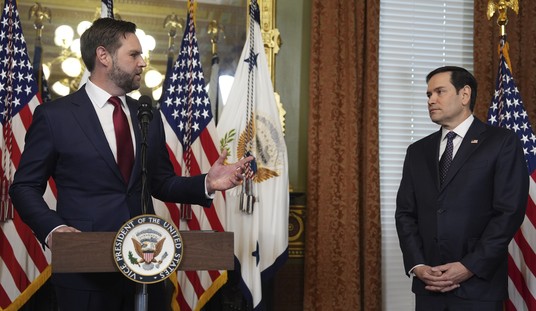It’s always worth paying attention to Sean Trende. If you don’t read him regularly at RCP, you may remember what he wrote right after the 2012 election. Most righty pundits at the time looked at the exit polls showing Latinos breaking lopsidedly for Obama over Romney and concluded that the GOP would need to tack to the center, and soon, on immigration to close that gap. Actually, countered Trende, it wasn’t the Latino vote that doomed Romney. It was the fact that millions of working-class white voters in the midwest, the sort of people who supported Ross Perot’s populist campaigns in the early 1990s, had decided to either stay home or choose Obama over Mitt. Find those “missing white voters,” he suggested, and the GOP might win again. He wrote that two days after Election Day 2012.
Four years later, his analysis looked … pretty good.
He’s hard at work these days poring over maps and charts and graphs and many, many numbers, and once again he finds himself uncomfortable with the conventional wisdom. Democrats are definitely going to pick up House seats on Tuesday night, he notes. It’s quite likely that they’ll pick up the couple dozen they need to flip the House. But a monster national wave of the sort that the GOP enjoyed in 2010? Not seeing it:
The most puzzling thing for me in this election (and the reason the scenario of Rs barely keeping/just barely losing the House keeps nagging at me) is this: the overall atmosphere isn't that atrocious for Republicans, and a lot of "big picture" signifiers of waves aren't here. 1/
— Sean T at RCP (@SeanTrende) November 2, 2018
We haven't seen a massive surge in Democratic party identification. The enthusiasm gap is present, but not really of the magnitude that we've seen in the past. And we typically see a big break at the end. Maybe by the end of the day I'll eat my words here 3/
— Sean T at RCP (@SeanTrende) November 2, 2018
But we also have a LOT of House seats that are polling within a point or two. If we get even a *slight* break among undecideds toward Republicans they end up keeping a lot of those seats. Of course, the opposite is true as well. 5/
— Sean T at RCP (@SeanTrende) November 2, 2018
and think "what the hell was I thinking?" Don't even get me started on the Senate, where I sort of feel like it will either be R+0 or R+5 without much room in the middle. But I guess that is what makes this fun. 7/7
— Sean T at RCP (@SeanTrende) November 2, 2018
His best guess right now is that Democrats will gain 32 seats, enough for a majority but not a large one — and while they could, of course, gain substantially more than that, they might also gain substantially less. There are various factors, starting with the booming economy, working against steep Democratic gains. Fellow elections analyst (and pollster) Kristen Soltis Anderson agrees:
In a wave election, two things seem to happen: Independents break heavily for one party, and that party’s voters are much more enthused about turning out than the other party’s. In 2006, Democrats won over independent voters by 18 points, and voters who planned to support Democrats were nine points more likely to report being enthusiastic about voting.
In 2010, it was the opposite; independents favored Republicans by 19 points, and voters who supported Republican candidates were 15 points more enthusiastic in Pew’s polling. Today? Independents favor Democrats on the generic ballot, but by smaller margins than they did in 2006. Furthermore, while interest in voting is way, way up among Democratic voters, the Pew study showed a nearly corresponding spike among Republicans, which additional data suggests brought Republicans to parity post-Kavanaugh confirmation.
If you want to see that point illustrated in graph form, here’s new data from Gallup:

Democrats led big in enthusiasm in 2006 — and cleaned up on election night. Republicans led big in 2010 and 2014 — and cleaned up on election night. This year, though? We’re in uncharted territory for recent midterm elections. Relatedly, here’s Gallup asking midterm voters this year and in the past whether they planned to turn out to show their support for the president’s agenda or their opposition to it:

In each of the last three wave midterms, the party that won big was at least 13 points more motivated to vote against the president than the president’s party was to vote to support him. This year the gap is just nine, and who knows what today’s stellar jobs report might do to that. It’s also worth noting that the numbers this year, both in terms of Republicans voting to show support for Trump and Democrats voting to show opposition, are the highest numbers in those two categories of any midterm dating back to 1998. More Republicans say they’re voting to express their support of POTUS this year than said so in 2002 of Dubya, a year after 9/11. Trump inspires such strong feelings on left and right that he may end up generating a ferocious electoral backlash and mitigating the extent of that backlash by inspiring his own fans to turn out in unusually high numbers.
As I write this the average generic ballot advantage for Democrats stands at 7.5 points, which also feels in line with Trende’s prediction of a solid but not world-beating and possibly even underwhelming Dem House win. Seven and a half points is a strong advantage but not the gory lead they had last winter, when Team Blue’s advantage touched 13 points for a few days. All of this is good news for the Senate, where the GOP stands to pick up a few seats so long as Democratic turnout doesn’t swamp Republican expectations. And it’s good-ish news in the House, in that it points to a smaller Dem majority. But don’t be unrealistic in setting your expectations. Anderson points out that 17 Republican seats are at least leaning Democratic right now and another 28 are pure toss-ups, meaning that if Dems hold on in the first group and bat just .500 in the second, they’ll flip the House. Even a mediocre night is probably enough for them to pull it off.
Plus, ask yourself this. What meaningful short-term difference is there to the average Republican voter between Democrats picking up, say, 32 seats, giving them a slender majority, and picking up 65 seats, giving them a fatter one? No left-wing bills are becoming law so long as the Senate and the White House are controlled by Republicans. The main consequence of the House changing hands will be Democrats gaining the power to perform oversight on Trump, replete with subpoena authority, but the size of their majority might not matter for that. So long as they have 218 votes for anti-Trump measures — which is likely, if only to weaken him ahead of the next election — they can go nuts. The size of their majority matters longer-term, of course, in that each seat that turns blue this year will have a blue incumbent in 2020, making it that much harder to flip back. But for the next two years, the size of the Democratic caucus will matter mainly insofar as a very narrow majority might make must-pass bills a risky proposition. For instance, if Pelosi and McConnell are trying to pass a spending bill that averts a shutdown and Pelosi only has a five-seat advantage, what happens if six House progressives say “nope” because the bill doesn’t increase spending enough? What happens if … 20 House progressives say that? Where do those missing votes come from? Something to ponder on Tuesday night as the returns are coming in.









Join the conversation as a VIP Member